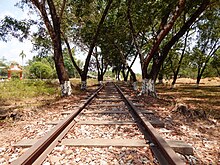
The Bridge on the River Kwai is a 1957 epic war film directed by David Lean and based on the 1952 novel written by Pierre Boulle.
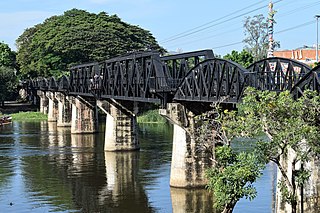
The Burma Railway, also known as the Siam–Burma Railway, Thai–Burma Railway and similar names, or as the Death Railway, is a 415 km (258 mi) railway between Ban Pong, Thailand, and Thanbyuzayat, Burma. It was built from 1940 to 1943 by South East Asian civilians abducted and forced to work by the Japanese and a smaller group of captured Allied soldiers, to supply troops and weapons in the Burma campaign of World War II. It completed the rail link between Bangkok, Thailand, and Rangoon, Burma. The name used by the Japanese Government was Tai–Men Rensetsu Tetsudō (泰緬連接鉄道), which means Thailand-Burma-Link-Railway.

Hellfire Pass is the name of a railway cutting on the former Burma Railway in Thailand which was built with forced labour during the Second World War, in part by Allied prisoners of war. The pass is noted for the harsh conditions and heavy loss of life suffered by its labourers during construction. It was called Hellfire Pass because the sight of emaciated prisoners labouring by burning torchlight resembled a scene from Hell.

Changi Prison Complex, often known simply as Changi Prison, is a prison complex in the namesake district of Changi in the eastern part of Singapore. It is the oldest and largest prison in the country, covering an area of about 50 ha. Opened in 1936, the prison has a rich history.

Richard Miller Flanagan is an Australian writer, who has also worked as a film director and screenwriter. He won the 2014 Man Booker Prize for his novel The Narrow Road to the Deep North.
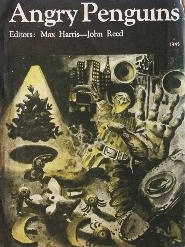
Angry Penguins was an art and literary journal founded in 1940 by surrealist poet Max Harris, at the age of 18. Originally based in Adelaide, the journal moved to Melbourne in 1942 once Harris joined the Heide Circle, a group of avant-garde painters and writers who stayed at Heide, a property owned by art patrons John and Sunday Reed. Angry Penguins subsequently became associated with, and stimulated, an art movement that would later be known by the same name. Key figures of the movement include Sidney Nolan, Arthur Boyd, Joy Hester, Gray Smith, and Albert Tucker.
Raymond Edward Parkin was an Australian naval seaman, writer, draftsman, artist and historian. He is noted for his memoirs of World War II, and for a major work on James Cook's Endeavour voyage.

The Bridge over the River Kwai is a novel by the French novelist Pierre Boulle, published in French in 1952 and English translation by Xan Fielding in 1954. The story is fictional but uses the construction of the Burma Railway, in 1942–1943, as its historical setting, and is partly based on Pierre Boulle's own life experience working in Malaysia rubber plantations and later working for allied forces in Singapore and Indochina during World War II. The novel deals with the plight of World War II British prisoners of war forced by the Imperial Japanese Army to build a bridge for the "Death Railway", so named because of the large number of prisoners and conscripts who died during its construction. The novel won France's Prix Sainte-Beuve in 1952.
Herbert James "Ringer" Edwards was an Australian soldier during World War II. As a prisoner of war (POW), he survived being crucified for 63 hours by Japanese soldiers on the Burma Railway. Edwards was the basis for the character Joe Harman in Nevil Shute's novel A Town Like Alice. The book was the basis for a 1956 film and a 1981 Australian television miniseries of the same name.

After World War II there were from 560,000 to 760,000 Japanese personnel in the Soviet Union and Mongolia interned to work in labor camps as POWs. Of them, it is estimated that between 60,000 and 347,000 died in captivity.

Ban Song Karia, also spelled Songkalia (ซองกาเลีย) and alternatively known as Songkurai, is a village in the Sangkhla Buri District of the Kanchanaburi Province, Thailand near the border with Myanmar at the Three Pagodas Pass. It was the location of three World War II Japanese Prisoner of War Camps located about 13 kilometres (8.1 mi) south of the Thai/Burma border.

The Railway Man is a 2013 war film directed by Jonathan Teplitzky. It is an adaptation of the 1995 autobiography of the same name by Eric Lomax, and stars Colin Firth, Nicole Kidman, Jeremy Irvine, and Stellan Skarsgård. It premiered at the 2013 Toronto International Film Festival on 6 September 2013.
Takashi Nagase was a Japanese military interpreter during World War II. He worked for the Kempeitai at the construction of the Burma Railway in Thailand, and spent most of his later life as an activist for post-war reconciliation and against Japanese militarism. He made over a hundred visits to Thailand, and from the 1970s, arranged several meetings between former Allied prisoners of wars and their Japanese captors, in efforts to promote peace and understanding. In 1993, he met and reconciled with British former POW Eric Lomax—in whose torture sessions Nagase had been involved—an encounter retold in Lomax's 1995 autobiography The Railway Man.
Lance Sergeant Kenneth Ignatius Harrison was an Australian anti-tank non-commissioned officer who fought in the Malayan Campaign. He was eventually captured by the Japanese, becoming a prisoner of war held initially at Changi in Singapore. When the war ended he was among the first foreigners to enter Hiroshima. After the war he became an author, writing about his experiences.
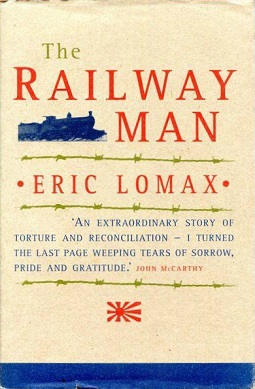
The Railway Man is an autobiographical book by Eric Lomax about his experiences as a prisoner of war during World War II and being forced to help build the Thai–Burma Railway for the Japanese military. The book won the NCR Book Award and the PEN/Ackerley Prize for autobiography.
The 2014 Man Booker Prize for fiction was awarded at a ceremony on 14 October 2014. Until 2014, only novels written in English and from authors in the Commonwealth, including the UK, the Republic of Ireland and Zimbabwe were eligible for consideration; however from 2014 rules were changed to extend eligibility to any novel written in English. It is therefore the first time in the award's history that authors from the United States of America have been included.
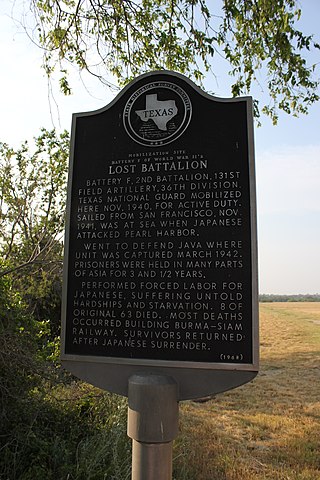
The Lost Battalion was the 2nd Battalion, 131st Field Artillery, 36th Infantry Division of the U.S. Army. The men of the battalion, plus the survivors of the sunken cruiser USS Houston, were captured by the Japanese on the island of Java in the Dutch East Indies in March 1942. It is called the lost battalion because the fate of the men was unknown to the United States until September 1944. They were prisoners of war for 42 months until the end of World War II. 534 soldiers from the battalion and 368 survivors of Houston were taken prisoner. Most of the men were sent to Thailand to work on the Burma Railway, the building of which is portrayed in the film The Bridge on the River Kwai. Of the 902 soldiers and sailors taken captive, 163 died in captivity. Most of the prisoners of war were from western Texas.

C56 31 was the 31st of the Class C56 steam locomotives produced by Japanese Government Railways (JGR). It was manufactured by Nippon Sharyo in 1936 and was operated on the Nanao Line in Ishikawa Prefecture before the war. C56 31 was the first locomotive to run on the Thai-Burma Railway, also known as the Death Railway. It operated there during the war, after which it was used in Thailand. After the war it was brought back to Japan and restored, and is now displayed in the Yūshūkan, the museum attached to Yasukuni Shrine in Tokyo. It is displayed without reference to the deaths during the construction of the railway, which are estimated at around 100,000.

Camp Nong Pladuk was a Japanese prisoner of war transit camp during World War II. It was located about five kilometres from the main railway station of Ban Pong near a junction station on the Southern Line to Bangkok. Nong Pladuk served as the starting point of the Burma Railroad. Numerous British, Dutch, and allied troops passed through Nong Pladuk to construct the railroad. Nowadays, it serves as a rail road maintenance and repair facility.
The Narrow Road to the Deep North is an upcoming Australian drama miniseries. It is based upon the novel of the same name by Richard Flanagan.

